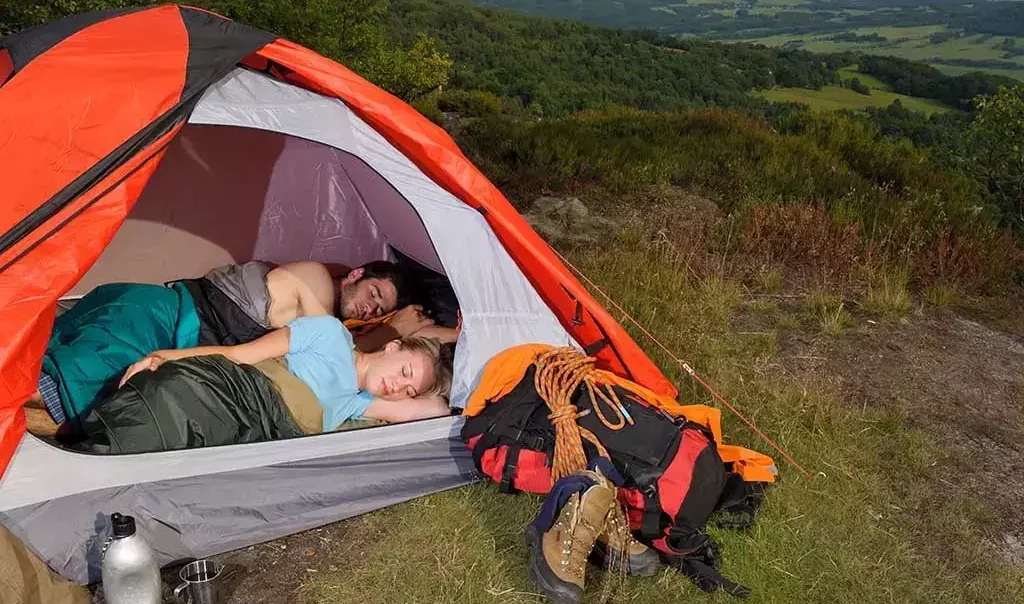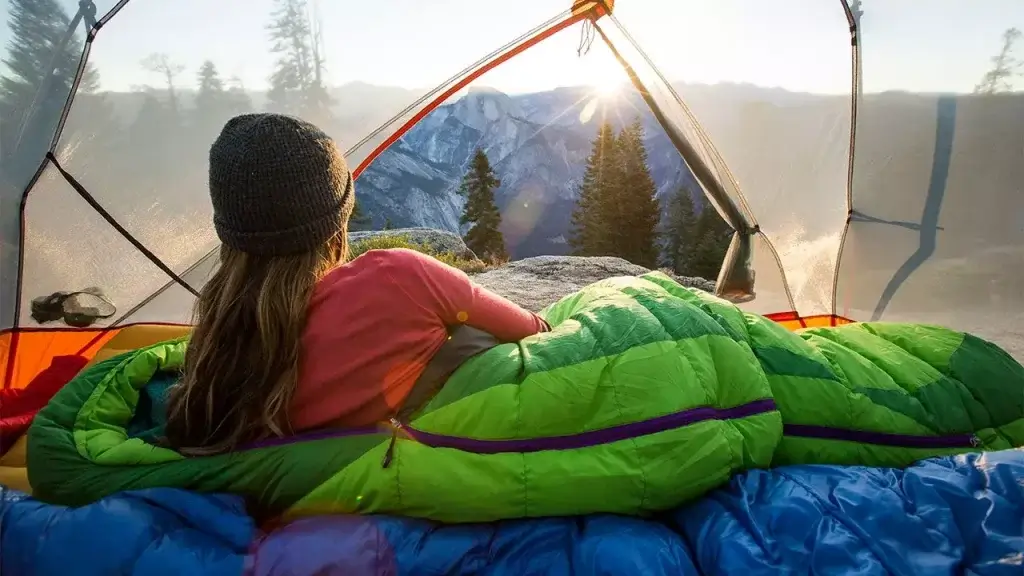Camping is a great way to get outdoors and enjoy nature. However, if you’re not used to sleeping in a tent, getting a good night’s sleep can be challenging. This blog post will discuss some tips and tricks that will help you get comfortable when sleeping in a tent.
We’ll also cover some of the most common problems people experience when trying to sleep in a tent and how to solve them. So whether you’re a seasoned camper or just getting started, read on for some helpful information.
The Practical Method to Sleep Well in a Tent

Most people have no idea the most comfortable way to sleep in a tent, but I will share it with you below.
Most of us have just rolled out our sleeping bags on the ground and gone to bed. But how do you know if this is truly the best way? Check the methods below:
1. Layer up: Go to bed wearing as many clothes as you’d typically wear to sleep in, as well as a hat and pair of socks. This will keep you warm throughout the night.
Be careful not to overdo it, though, as overheating can cause discomfort when sleeping in a tent. If you’re too hot, open the vents in your tent or remove some of your layers.
2. Air it out: If you’ve recently been to the gym, sprayed perfume, eaten something spicy, etc., don’t sleep in those clothes. Most fabrics are breathable when left to air for a short while after wearing them.
When you’re camping, though, you don’t have that time, so get rid of any smells or tastes by changing into different clothes.
3. Use a sleeping bag: If you’re going camping in the colder months of the year, it’s advisable to use a sleeping bag that will keep you warm throughout your sleep. Most bags are made up of high-quality materials that trap heat very well.
4. Use a sleeping pad: Most tents come with cheap, uncomfortable sleeping mats that can be hard on your back when you sleep in them for an extended period.
You can either go without a mat or get a better one to make the experience of sleeping in a tent comfortably. Most of our customers choose to use a sleeping pad such as the Therm-a-Rest Ridge Rest.
5. Sleeping bags can also be used on top of mats to add extra insulation and padding: Most mats are thin, so if you want to sleep comfortably, using a sleeping bag on top of your mat is our most recommended course of action.
This will make it feel more like you’re sleeping in a bed than on the ground. Most of our customers choose to do this with their Ridge Rest pads.
6. Get an air mattress: Most high-quality air mattresses are self-inflating, meaning that you can open them up, and they will inflate all on their own.
Air mattresses are very comfortable alternatives to sleeping on the ground, making an already comfortable situation even better. Most of our customers choose to sleep with an air mattress instead of a mat, such as the Coleman Self-Inflating Mattress.
7. Most tents come with one or two vents on the roof: Open both vents during the day to allow hot air to escape from the tent. At night, close these vents to keep warm air in.
Most tents will have a rain cover that you can use if it’s raining outside. Most of our customers choose to use this rain cover instead of opening the vents because it keeps them warmer at night while allowing water to pass through, should it rain.
8. If you can, sleep with your feet facing the door of your tent: This way, when you wake up in the morning, you won’t be too far from it. Most tents will have only one door (although some larger ones may have two), so make sure to choose a spot where nothing is obstructing your path to the door.
Sleeping in this position also makes it easier to get out of your tent should you need to pee in the middle of the night because you’ll know which direction leads closer to your destination.
Most of our customers choose to sleep with their feet facing the door, so they don’t have too far to go if they need to use the bathroom in the middle of the night.
9. Most air mattresses are not designed to be slept on with two people: If you’re planning on sharing your air mattress with a partner, make sure that there is no overlap between your sleeping areas.
Otherwise, one person will end up trying to sleep at an angle that won’t feel as comfortable as it should. Most of our customers choose to sleep on their air mattresses by themselves because most beds are not designed for more than one person.
10. Most sleeping bags have a right and a left side: Most sleeping bags come with labels attached that tell you which way is up, so you don’t have to worry about rolling around too much during your sleep.
Most of our customers follow these instructions, so they don’t have to think about which way is up while they’re sleeping, allowing them to focus on getting comfortable instead of trying not to roll around.
How to Keep Yourself Warm at Night
If you are cold, you won’t get comfortable sleeping in a tent. Most of the time, this is because your fleece jacket isn’t warm enough or due to wet socks.
Getting warm is more accessible than staying warm, so make sure to keep these factors in mind. For example, try laying your raincoat over your sleeping bag if it’s raining.
You can also use a sleeping pad as an extra layer to trap the heat inside. Most recommend using a closed-cell foam pad, which will help insulate you against the cold ground and provide support.
For added comfort and warmth, try placing your camping pillow under your legs or head. You can even put clothes on your pillow since that’s where you’ll be resting your face.
Additional Tips To Sleep in A Tent Comfortably

1. Not being able to get comfortable
If you’re having trouble getting comfortable when sleeping in a tent, here are a few tips that might help. First, try using a camping cot or air mattress. This will provide some extra comfort and support.
Additionally, make sure you bring along plenty of bedding, such as a sleeping bag, blankets, and pillows. Finally, if it’s cold outside, you might also want to consider using a thermal liner for your sleeping bag.
2. Feeling cramped or claustrophobic
If you’re feeling cramped or claustrophobic when trying to sleep in a tent, try pitching the tent on a larger patch of ground. This will give you more room to move around and stretch out. Additionally, make sure the tent is well-ventilated; this will help prevent feelings of claustrophobia.
3. Being too hot or too cold
If you’re having trouble staying comfortable when sleeping in a tent, it might be because you’re either too hot or too cold. In this case, try using a sleeping bag designed for your specific climate.
Additionally, bring plenty of warm clothes and blankets if it’s cold outside, and pack some lighter clothing if it’s hot.
4. Being disturbed by noise
If you’re being disturbed by noise when trying to sleep, there are a few things you can do. First, make sure your shoes and other belongings are packed away somewhere in the tent where they won’t be in the way when you’re moving around during the night.
Second, invest in some earplugs; this will help ensure you don’t hear any random noises that might disrupt your sleep.
5. Not falling asleep quickly and easily
If you find it difficult to fall asleep when trying to sleep in a tent, try using some methods to help you relax and clear your mind before bedtime. For example, meditation, hot baths, watching TV, or reading a book can all be helpful ways of relaxing and falling asleep more easily.
What Is The Best Time To Sleep On When Camping?
One of the most common yet significant questions about camping is when to sleep on. Most think they should sleep on a diagonal, which isn’t the case at all. Your body will often fit in a tent better if you lie down vertically rather than diagonally.
The best time to sleep is somewhere between 8 and 9 pm, when it’s dark enough not to see anything but too early for other animals or bugs to be active.
Most campsites should have bathrooms; if you need to use the bathroom at night, make sure that you do it as quietly as possible. Also, remember that your body is used to sleeping in a bed and may need time to adjust to the change in location.
This also goes for resting, in general. Most people are used to having a certain amount of things around them to sleep well.
Some common sleep aids are earplugs or white noise, but make sure you don’t bring anything you don’t want to lose when you’re camping. For example, your phone will likely be dead after a weekend of camping, so there is no need to bring it along.
Conclusion
As you can see, the Most Comfortable Way To Sleep In A Tent is to sleep on top of EACH OTHER. This way, there is no hard ground, and the dew (if it even exists) does not ever touch your skin.
If you are still concerned about the elements around you not supporting your weight, put a jacket on the ground and sleep upon it. There will be enough insulation from your body heat trapped between you and either your bag or jacket most of the time.

